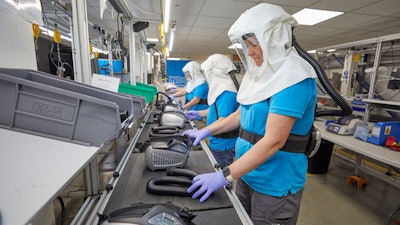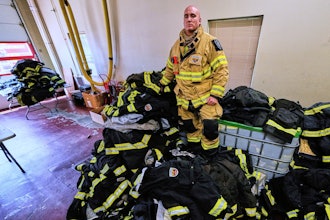
Research by the University of Southampton and University Hospital Southampton has demonstrated that a newly-developed respirator hood is a safe form of personal protective equipment (PPE) for frontline healthcare workers and support staff. As well as being preferred by patients and staff to standard facemasks, they provide cost saving opportunities for the NHS and did not face the supply chain issues experienced for single-use PPE early in the pandemic.
At the start of the pandemic, a collaboration of University and Hospital staff, with industry partners, developed prototype reusable, battery-powered respirators (PeRSo) as alternative PPE to standard disposable face masks. After initial trials, widespread deployment was approved; in the first wave, over 1,500 PeRSos were used, and over 3,500 were used during the second wave, all individually requested by staff.
The respirators have a waist-mounted rechargeable battery powered unit, which filters air extremely effectively and then blows clean air into a loose-fitting hood with a clear visor. They received approval from the regulators for use in hospitals during the pandemic.
 PeRSo on the frontline.University Hospital Southampton
PeRSo on the frontline.University Hospital Southampton
The key findings of the study published in Frontiers in Medical Technology were that the respirators were significantly preferred by staff, as they felt safer and more comfortable, and preferred by patients who could see their carers’ faces in full, making communication much easier.
Economic analysis showed widespread PeRSo use to be cost saving after approximately ten weeks, and as they are reusable the supply chain issues that limited PPE availability were resolved. The environmental impact of disposable PPE was also minimized.
Furthermore, widespread use led to relatively low staff absence during the second wave of the pandemic, and over 80% of staff requested their PeRSos to be stored for any future rise in cases. This improved PPE was offered to all staff, including cleaners, porters, physiotherapists and healthcare assistants.
The team therefore conclude that PeRSos represent an alternative form of PPE to protect healthcare workers from coronavirus infection.
Paul Elkington, Professor of Respiratory Medicine at the University of Southampton and co-director of the project, said “We have shown that widespread PeRSo use gives staff the ability to choose their level of PPE, and is preferred by staff and patients. Also, this approach reduces the enormous waste of standard PPE and is cost saving as the respirators are reusable“.
Dr. Trevor Smith, Deputy Chief Medical Officer at University Hospital Southampton, said “this is a prime example of the local hospital, university and industry working together to come up with innovative a solution to the crisis that has benefited patients and staff alike. Our experience can help the wider NHS to improve its PPE provision as we enter a difficult winter”.
 PeRSo on the Frontline 2.University Hospital Southampton
PeRSo on the Frontline 2.University Hospital Southampton






















